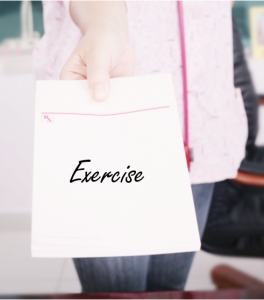Depression in children and adolescents can be a serious and sometimes deadly problem. With renewed concern about the over-reliance of antidepressant medication, effective nonpharmacological interventions are highly welcome. Psychotherapy has been shown to be an important treatment for many, but availability and patient follow-up can be challenging. Exercise has been shown to be a promising treatment for adults; however, the literature for younger patients has been somewhat unsettled. To get a more definitive sense of these  studies, a recent meta-analysis on the subject was recently published in the Journal of the American Academy of Child & Adolescent Psychiatry.
studies, a recent meta-analysis on the subject was recently published in the Journal of the American Academy of Child & Adolescent Psychiatry.
The authors searched for randomized controlled trials of adolescents between 13 and 17 years of age that used exercise promotion strategies or specific exercise protocols. As some but certainly not all of the studies were performed with nonclinical samples, the primary outcome for this meta-analysis were scores on quantitative depression-related rating scales. A total of 11 trials encompassing 1,449 participants were identified from as early as 1982. While the specific exercise regimen varied across studies, the majority involved some kind of supervised group aerobic and/or strength training around three times per week for 6 to 40 weeks.
Overall, exercise was found to have a moderate and statistically significant effect on reducing depressive symptoms. The overall effect size was about one-half of a standard deviation which is considered moderate. When the authors divided the sample between clinically depressed and community samples, they found continued support for the benefits of exercise for the clinical group but not from samples taken from the general population (although the effect size was roughly the same for both groups, suggesting that perhaps sample size and/or response variability was the problem in studies done with community samples).
The authors concluded that exercise appears to be a promising strategy to diminish depressive symptoms in adolescents. While certainly not a miracle cure, it is difficult to see why clinicians would not want to include exercise in his or her treatment plan for depression, given its many other benefits.
Despite these optimistic reports, a number of important issues need further study. One of them is determining the optimal exercise regimen to maximize the antidepressant effect. While many of these studies used 3 times per week of low to moderate intensity programs, it is certainly possible that other approaches might work just as well if not better, particularly those that encouraged daily exercise. Another important question relates to medication. While many of us are eager to find effective alternatives to antidepressant medications, this study unfortunately has no direct data on how exercise might be used instead of or in addition to other treatments.
As a practical support of these principles, Vermont will once again be offering the Vermont Parks Prescription program supported by the Governor’s Council on Physical Fitness and Sports and The Vermont Department of Forest Parks and Recreation. It allows Vermont clinicians to distribute “prescriptions” for exercise which then allow free access to a Vermont State Park. Physicians and other health care professionals who would like more information or would like to receive some of these vouchers can contact vermontfitness@vermont.gov .
Reference
Carter T. The effect of exercise on depressive symptoms in adolescents: A systematic review and meta-analysis. JAACAP 2016; Epub ahead of print.

